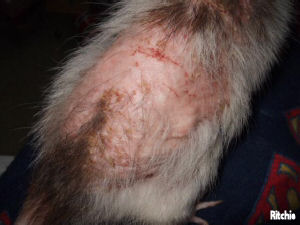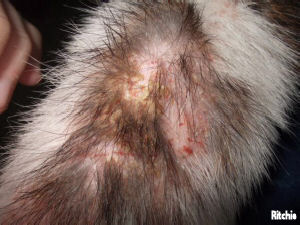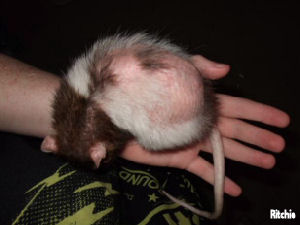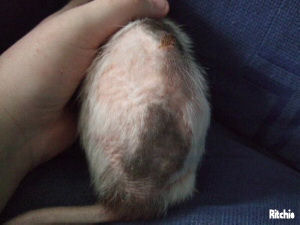Figure 5: Superficial pyoderma in a 28-month-old male (Ritchie).
Case history and photos
History
Ritchie is a 28-month-old male. He was taken to seek veterinary assistance for what was believed to be a bad case of mites. One year prior to the recent issues, he was treated successfully for Demodex mange mites using Panomec injections and massages of Benzyl Benzaote once/twice weekly (as required).
Clinical Signs
In October 2007 Ritchie presented with redness of the skin, increased thirst and some mild hair loss. Treatment of massaging Benzyl Benzaote once weekly into skin was given but no improvement.
In December 2007 symptoms progressed. The redness of his skin remained as did the increased thirst. He lost weight and the hair loss gradually became more severe.
By April 2008 symptoms also included crusted areas (resembling scabs) that laid upon the skin.
Initial Treatment
Ritchie was initially treated for mites and given irregular Panomec injections (up to April 2008) as well as dexamethasone injections for the inflammation of his skin and Baytril. Little improvement was seen.
Diagnosis
An initial skin scraping was negative for any mites; however a second scraping one week later did show the presence of staphylococci as well as neutrophils, and the diagnosis of pyoderma was confirmed.
Follow-up Treatment
Ritchie was given an initial injection of Synulox (Clavamox in the US) and placed on a long course of Synulox tablets. The owner was instructed to bathe him 3 times per week in Maloseb/VET Universal Medicated Shampoo (antibacterial and antifungal medicated shampoo) which was to be diluted in a bathtub to decrease discomfort of direct application on his sore skin. He was to soak in these baths for 10-15 minutes at a time.
Outcome
Encouraging results were seen almost immediately. The scabs were soaked off, the redness of the skin decreased, and his thirst normalized within the first few baths. Within 3 weeks of treatment the scab formation had slowed and new fur growth could be seen. The Synulox was discontinued but the medicated baths were to carry on. Within 6 weeks of treatment the baths were decreased to twice weekly. New fur was coming through rapidly and Ritchie was feeling much happier.
By July 2008 the medicated baths were decreased to once weekly. A slight setback (end of May) of a fight wound on his back meant that he was unable to be bathed for two weeks and the scab formation restarted on a very small scale. Once the baths were started up once again, the formation of new scabs stopped completely within a couple of weeks.
Unfortunately on the 16th of July 2008, Ritchie passed on due to natural causes, but at that point he had managed to have two weeks bath-free with no further scabs forming, and the majority of his fur returning.
Photos
 Photo 1: April 22 – Pyoderma at its most severe point for Ritchie. The scabs covered the majority of his back and shoulders. |
 Photo 2: May 1 – The scab formation has slowed with medicated baths. |
 Photo 3: May 1 – A view of the scabs under the fur on his shoulders. |
 Photo 4: May 7 – Scabs have almost completely disappeared, and new fur growth is starting in patches. Considerable fur was lost during the baths while soaking off of the scabs. |
 Photo 5: May 7 – A full view of Ritchie. |
 Photo 6: May 11 – New hair growth can be seen. |
 Photo 7: May 21 – Further progress with more new hair growth. |
 Photo 8: June 1 – Scabbing has now almost ceased and the baths have been reduced. |
 Photo 9: Ritchie during one of his medicated bath treatments. These soaks lasted 15 minutes. |
 Photo 10: June 30 – Scabbing has now ceased. The baths have been discontinued, and new fur continues to grow. |
Case history and photos courtesy of Ration1802: Dedicated to Ritchie


